Historic Cochiti Pueblo Animal Figurine - 25902
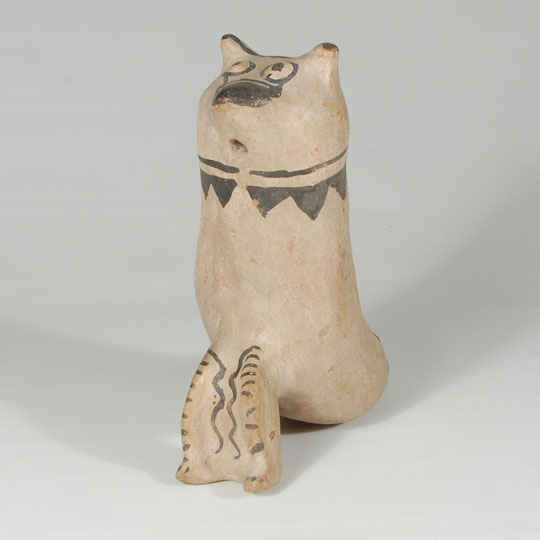 My opinion is that this Cochiti Pueblo figurine represents a cat but I am not absolutely sure of that. There is a long tail curled up on the back side, a tail like that of a cat. It could represent another animal. Regardless, it is so typical of early 20th century animal figurines by potters from Cochiti Pueblo. There is no potter's name associated with it.
My opinion is that this Cochiti Pueblo figurine represents a cat but I am not absolutely sure of that. There is a long tail curled up on the back side, a tail like that of a cat. It could represent another animal. Regardless, it is so typical of early 20th century animal figurines by potters from Cochiti Pueblo. There is no potter's name associated with it.
Very Old Cochiti Pueblo Figurine - 25903
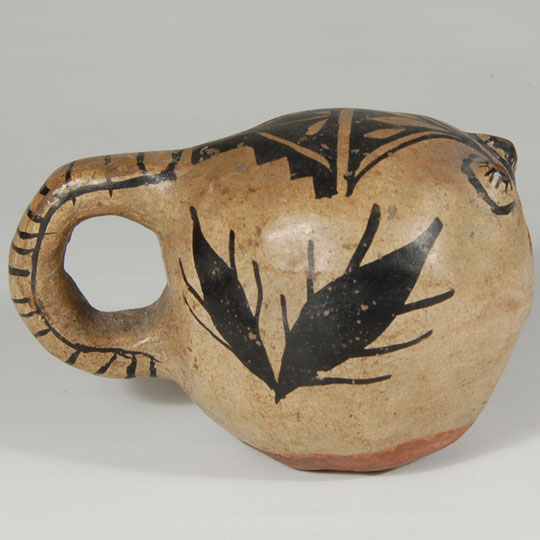 I guess this Cochiti Pueblo figurine represents what you think it represents. To me, it looks like a blow fish but I'm sure there are no blow fish in Cochiti Lake. It is rather unique from the standpoint of having a handle attached. I believe it to date to very early 20thcentury. There is no artist name written on it.
I guess this Cochiti Pueblo figurine represents what you think it represents. To me, it looks like a blow fish but I'm sure there are no blow fish in Cochiti Lake. It is rather unique from the standpoint of having a handle attached. I believe it to date to very early 20thcentury. There is no artist name written on it.
Zuni Pueblo Shalako and Koyemsi Katsina Pair by Homer Sowtey - C3383ZT
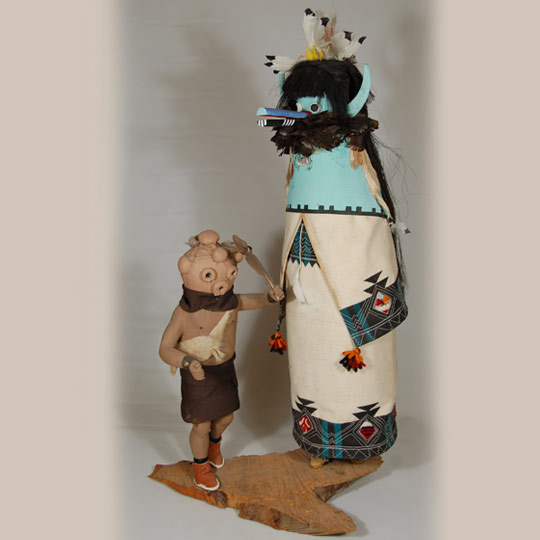 Shalako, a reenactment of the creation and migration of the Zuni people to "Heptina," the "Middle Place," has persisted through the centuries. The religious activities are controlled by "caciques" of the six kivas, representing the four directions and up and down, which constitute the dance groups, and each kiva is associated with a direction, a color, and certain fetishes.
Shalako, a reenactment of the creation and migration of the Zuni people to "Heptina," the "Middle Place," has persisted through the centuries. The religious activities are controlled by "caciques" of the six kivas, representing the four directions and up and down, which constitute the dance groups, and each kiva is associated with a direction, a color, and certain fetishes.
Myron Denetclaw - 9th Annual Historic Canyon Road Paint Out
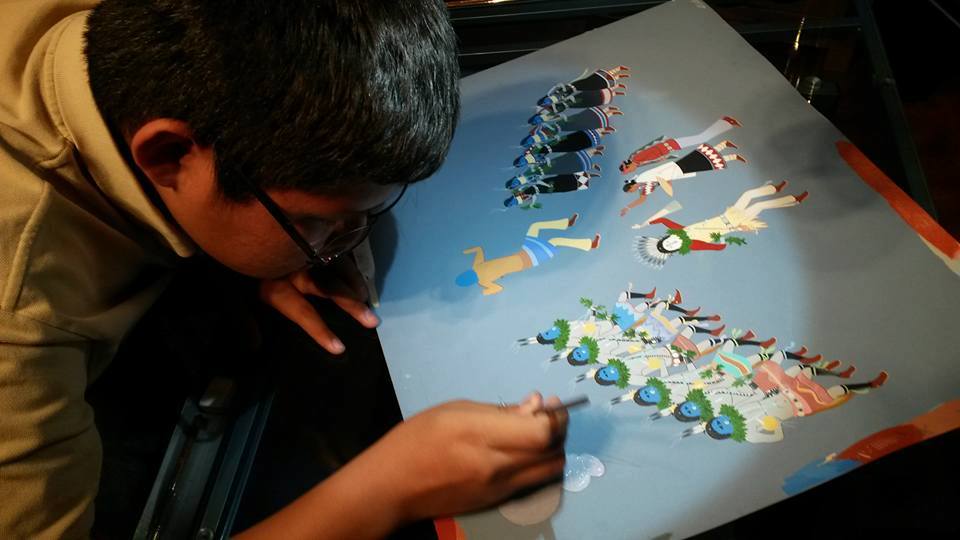
Adobe Gallery 221 Canyon Rd, Santa Fe, New Mexico 87501
Ninth Annual Historic Canyon Road Paint & Sculpt Out Saturday, October 14th-15th, 2016
ARTIST SIGN-UP 1. artist name, 2. media, 3. genre and 4. hometown. 5. Gallery
1. Myron Denetclaw
2. Watercolor and Acrylic on Matte Paper
3. Indian School Style or Flat Style
4. Diné - Navajo Nation
5. Adobe Gallery
4-5 interesting things about the artist and his/her work listed in the body of an email.
1. He is a natural born artist and has not received any structured or official training as a painter.
2. Chooses to paint in the Indian School Style or Flat Style that was started in the early 1900's, first by the San Ildefonso Day School and then at the Santa Fe Indian School in the 1930s.
3. A Native artist, he is from the Navajo Nation.
4. Recent ribbon winner at the New Mexico State Fair - won BEST OF SHOW. "First time have I painted horses and wildlife... entitled 'Nightway: Ceremonial Hunt'. Three Navajo hunters galloping after three deer for their use in making sacred masks, used in 9-day winter rites. 18 × 24 inches, framed, acrylic on matte paper."
Hopi-Tewa Polychrome Cylindrical Jar by Nampeyo of Hano - C3801D
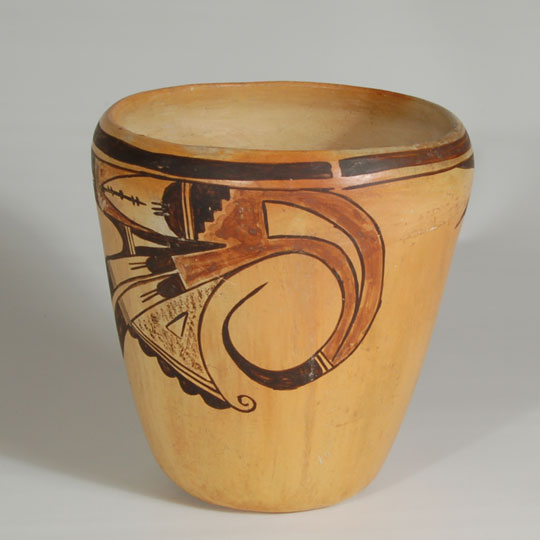 It is generally accepted that a potter will not knowingly copy the designs of another potter and a family of potters will not knowingly copy the designs associated with another family of potters. With that in mind, we take a look at the designs of this Hopi-Tewa cylinder.
It is generally accepted that a potter will not knowingly copy the designs of another potter and a family of potters will not knowingly copy the designs associated with another family of potters. With that in mind, we take a look at the designs of this Hopi-Tewa cylinder.
The stylized birds on this cylinder are of the style that Nampeyo of Hano used based on her exposure to the pottery sherds being excavated at the prehistoric ruins ofSikyatki. Nampeyo is known to not have copied the designs of the Sikyatki potters, but to have been inspired by them and based her designs on what she saw.
Black Carved Wedding Vessel with Twisted Arch Handle by Helen Shupla - C3830A
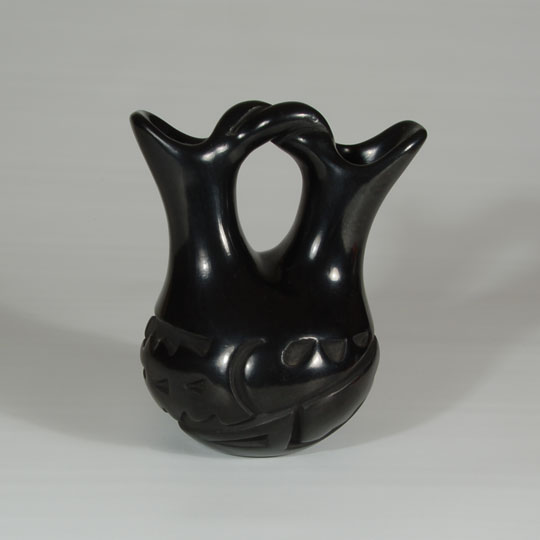 Many potters today make wedding vessels but there seems no longer a tradition at any of the pueblos to use them ceremonially. They apparently are made to be sold to collectors and as wedding gifts to others as a keepsake.
Many potters today make wedding vessels but there seems no longer a tradition at any of the pueblos to use them ceremonially. They apparently are made to be sold to collectors and as wedding gifts to others as a keepsake.
There was a time, according to Santa Clara potter Teresita Naranjo, when the wedding vessel was used at Santa Clara Pueblo.
Carved Black Cylindrical Jar from Santa Clara Pueblo by Helen Shupla - C3830B
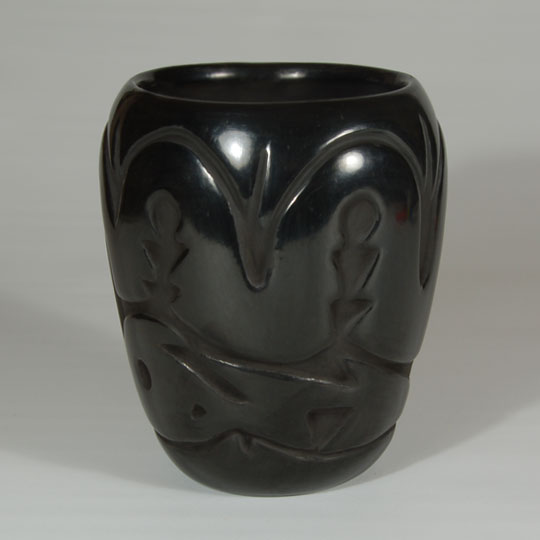 When Stephen Trimble published his book Talking with the Clay-the Art of Pueblo Pottery in 1987, he put a grouping of Helen Shupla's black and red pottery on the cover, another grouping of her pottery facing Chapter Three, and mentioned her in the text on page 47. This is an indication of his admiration for her work. In Betty LeFree's book Santa Clara Pottery Today, published in 1975, she interviewed Helen Shupla and quoted her in regard to the proper mixing of clay. She chose Helen because of her production of fine pottery.
When Stephen Trimble published his book Talking with the Clay-the Art of Pueblo Pottery in 1987, he put a grouping of Helen Shupla's black and red pottery on the cover, another grouping of her pottery facing Chapter Three, and mentioned her in the text on page 47. This is an indication of his admiration for her work. In Betty LeFree's book Santa Clara Pottery Today, published in 1975, she interviewed Helen Shupla and quoted her in regard to the proper mixing of clay. She chose Helen because of her production of fine pottery.
Original Acrylic Painting “Mimbres Man and His Shadow” by Helen Hardin C3406B
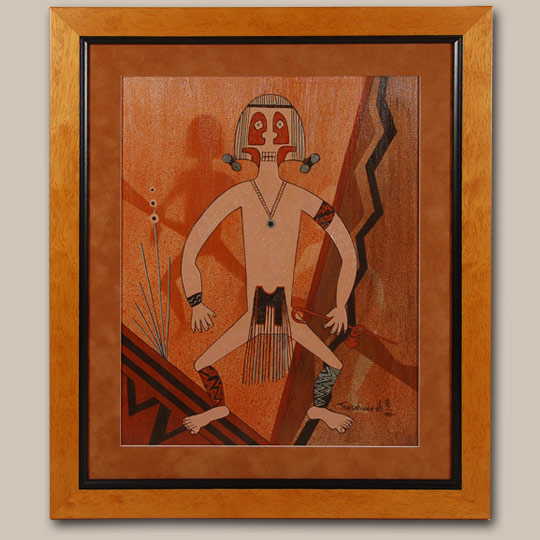 Helen Hardin (1943-1984) Tsa-Sah-Wee-Eh - Little Standing Spruce was from Santa Clara Pueblo. From the very beginning of her career, was at the cutting edge of Indian-influenced art. Her art, though obviously drawing on her Indian heritage and tradition, was very much in the mainstream of modern aesthetics.
Helen Hardin (1943-1984) Tsa-Sah-Wee-Eh - Little Standing Spruce was from Santa Clara Pueblo. From the very beginning of her career, was at the cutting edge of Indian-influenced art. Her art, though obviously drawing on her Indian heritage and tradition, was very much in the mainstream of modern aesthetics.
This painting of Hardin's is truly a work of exceptional drafting skills and superlative technical rendering. Quite extraordinary and striking, as the work of Hardin tends to be, it displays a true sense of the complexities and intricacies involved in the creation of such a piece.
Original Acrylic Painting “Santo Domingo Garden Bird” by Helen Hardin C3406D
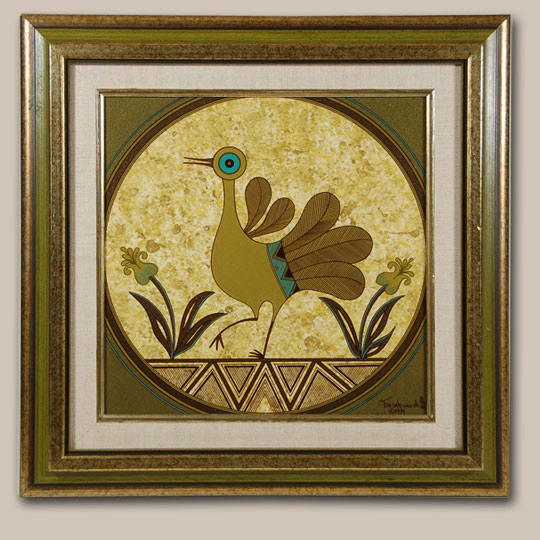 Helen Hardin (1943-1984) Tsa-Sah-Wee-Eh - Little Standing Spruce was from Santa Clara Pueblo. From the very beginning of her career, she was at the cutting edge of Indian-influenced art. Her art, though obviously drawing on her Indian heritage and tradition, was very much in the mainstream of modern aesthetics. This fine acrylic painting on artist board is dated 1979. It is a drawing of a bird, which she describes as from Santo Domingo Pueblo. It is a work exhibiting exceptional drafting skills and superlative technical rendering. It is quite exceptional and striking, as the work of Helen Hardin tends to be, with a true sense of the complexities and intricacies involved in the creation of such a work
Helen Hardin (1943-1984) Tsa-Sah-Wee-Eh - Little Standing Spruce was from Santa Clara Pueblo. From the very beginning of her career, she was at the cutting edge of Indian-influenced art. Her art, though obviously drawing on her Indian heritage and tradition, was very much in the mainstream of modern aesthetics. This fine acrylic painting on artist board is dated 1979. It is a drawing of a bird, which she describes as from Santo Domingo Pueblo. It is a work exhibiting exceptional drafting skills and superlative technical rendering. It is quite exceptional and striking, as the work of Helen Hardin tends to be, with a true sense of the complexities and intricacies involved in the creation of such a work
Historic Hopi Polychrome Helmet-style Serving Bowl - C3632B
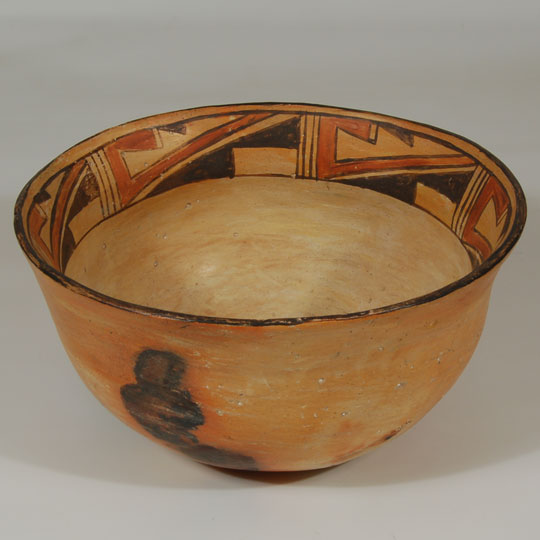 A large part of the charm of Hopi pottery is the warm orange blush achieved during firing and deep black fire clouds resulting from firing. Coal firing is responsible for these attributes. This bowl has both a warm blush and a beautiful array of fire clouds on the exterior. The vessel shape has been referred to as a helmet-shape, based on such shapes of World War I helmets, but there certainly is no connection between the Hopi's development of this shape and the commercial development of the war helmets.
A large part of the charm of Hopi pottery is the warm orange blush achieved during firing and deep black fire clouds resulting from firing. Coal firing is responsible for these attributes. This bowl has both a warm blush and a beautiful array of fire clouds on the exterior. The vessel shape has been referred to as a helmet-shape, based on such shapes of World War I helmets, but there certainly is no connection between the Hopi's development of this shape and the commercial development of the war helmets.
Historic Kewa Pueblo Deep Serving Bowl with Interior Design - 24161
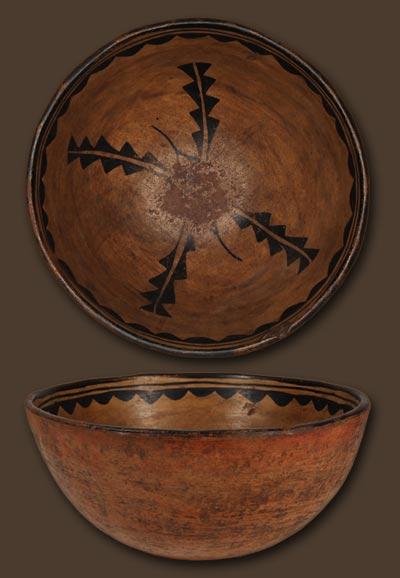 This is an extraordinary fine Santo Domingo serving bowl that follows the pueblo's traditions in every aspect of materials, construction and design. The interior of the bowl is decorated in black vegetal paint over the traditional cream-colored rag-wiped bentonite slip. The exterior is without decoration, with the exception of a wide red band wiped onto the surface just below the rim. The natural clay exterior of the bowl was stone polished.
This is an extraordinary fine Santo Domingo serving bowl that follows the pueblo's traditions in every aspect of materials, construction and design. The interior of the bowl is decorated in black vegetal paint over the traditional cream-colored rag-wiped bentonite slip. The exterior is without decoration, with the exception of a wide red band wiped onto the surface just below the rim. The natural clay exterior of the bowl was stone polished.
San Ildefonso Pueblo Polychrome Small Jar by Carlos Dunlap, Jr. - C3810
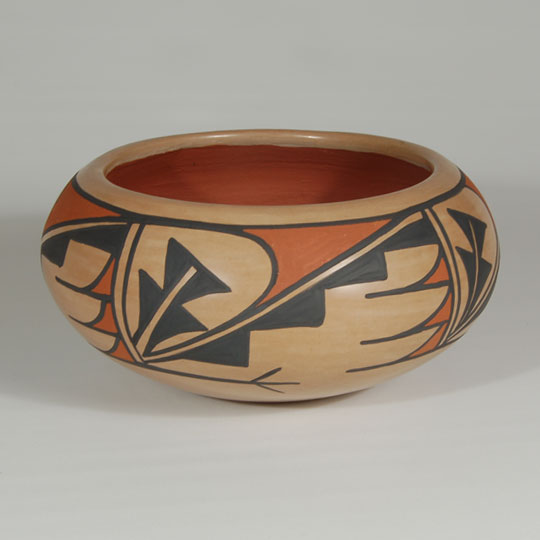 Carlos Dunlap, Jr. was the son of San Ildefonso potter Carmelita Dunlap and San Carlos Apache artist Carlos Dunlap, Sr. He was an excellent potter and painter of pottery. His, as well as his mother's, pottery was generally large in scale and thick-walled-more so than traditional San Ildefonso wares. He painted his pieces with traditional designs executed with precise detail.
Carlos Dunlap, Jr. was the son of San Ildefonso potter Carmelita Dunlap and San Carlos Apache artist Carlos Dunlap, Sr. He was an excellent potter and painter of pottery. His, as well as his mother's, pottery was generally large in scale and thick-walled-more so than traditional San Ildefonso wares. He painted his pieces with traditional designs executed with precise detail.
Historic Zuni Pueblo Olla with Frogs in Bas Relief - C3367F
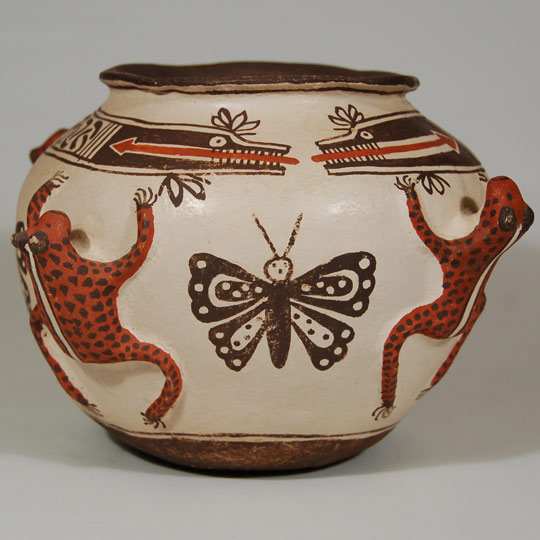 During the time that Indian Trader C. G. Wallace was active at Zuni Pueblo, in the 1920s and later, Zuni potters responded to the increased demand for pottery. The 1920s was a revival period for pottery after a lapse of a couple decades of less interest.
During the time that Indian Trader C. G. Wallace was active at Zuni Pueblo, in the 1920s and later, Zuni potters responded to the increased demand for pottery. The 1920s was a revival period for pottery after a lapse of a couple decades of less interest.
Hopi Pueblo Original Painting “No Time for Ogres” by Neil David, Sr. - C3624E
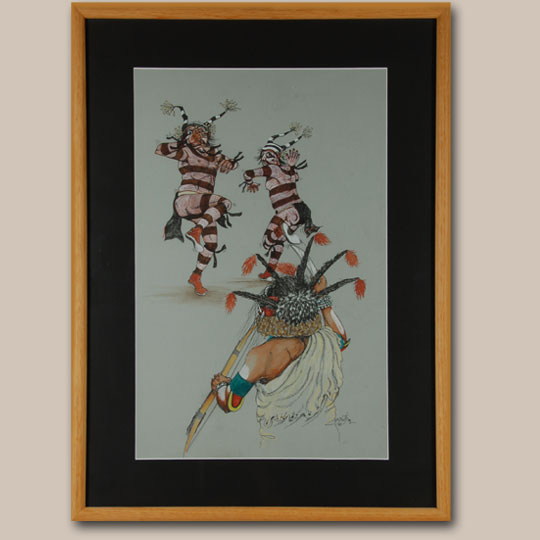 Neil David, Sr. (1944-Present) is nationally known for his paintings and carvings of Hopi-Tewa clowns called Koshare. He has an innate feel for picturing their antics when they are interacting with Katsinas or when they are acting solo and being gluttons.
Neil David, Sr. (1944-Present) is nationally known for his paintings and carvings of Hopi-Tewa clowns called Koshare. He has an innate feel for picturing their antics when they are interacting with Katsinas or when they are acting solo and being gluttons.
Historic Cochiti Pueblo Jar with Collar Neck - 25711
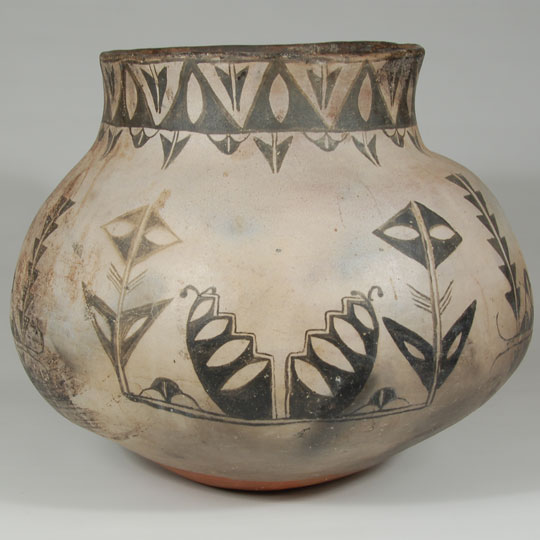 Stevenson and Cushing, in 1879, and Stevenson, again, in 1880, made collections at Cochiti Pueblo and they noted that the majority of pieces being made there were figurative pieces and effigy vessels, with almost no ollas or bowls being made. (Batkin 1987). This has been a long tradition at Cochiti. It is interesting that they were so involved in making figurative pottery for tourist consumption when they really were not near Route 66 or other tourist traveled locations. They must have traveled into Santa Fe to sell their pottery to traders in town because it is not likely that tourists traveled the road to the pueblo.
Stevenson and Cushing, in 1879, and Stevenson, again, in 1880, made collections at Cochiti Pueblo and they noted that the majority of pieces being made there were figurative pieces and effigy vessels, with almost no ollas or bowls being made. (Batkin 1987). This has been a long tradition at Cochiti. It is interesting that they were so involved in making figurative pottery for tourist consumption when they really were not near Route 66 or other tourist traveled locations. They must have traveled into Santa Fe to sell their pottery to traders in town because it is not likely that tourists traveled the road to the pueblo.
Seated Female Cochiti Pueblo Storyteller with 14 Children by Louise E. Suina - C3625
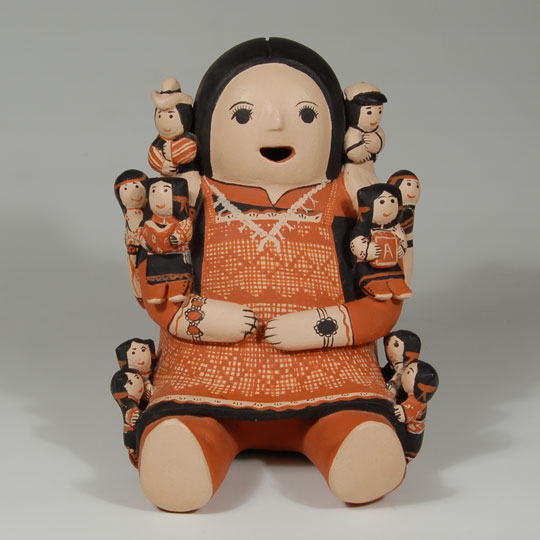 I am not familiar with the artist of this storyteller figurine, Louise E. Suina, but she certainly did an excellent job of making and decorating this one. The intricate apron on the adult is beautifully painted and each of the 14 children is painted to perfection. The boys are outfitted with a cowboy hat, baseball cap or a traditional headband. The girls are dressed in traditional pueblo dresses and some carry items in their hands. Overall, this is an excellent southwest Indian pottery storyteller figurine presentation. It is signedLouise E. Suina, Cochiti, N.Mex. on the underside.
I am not familiar with the artist of this storyteller figurine, Louise E. Suina, but she certainly did an excellent job of making and decorating this one. The intricate apron on the adult is beautifully painted and each of the 14 children is painted to perfection. The boys are outfitted with a cowboy hat, baseball cap or a traditional headband. The girls are dressed in traditional pueblo dresses and some carry items in their hands. Overall, this is an excellent southwest Indian pottery storyteller figurine presentation. It is signedLouise E. Suina, Cochiti, N.Mex. on the underside.
Hopi Pueblo Acrylic Painting “Ceremonial Still Life” by Lomawywesa - C3624A
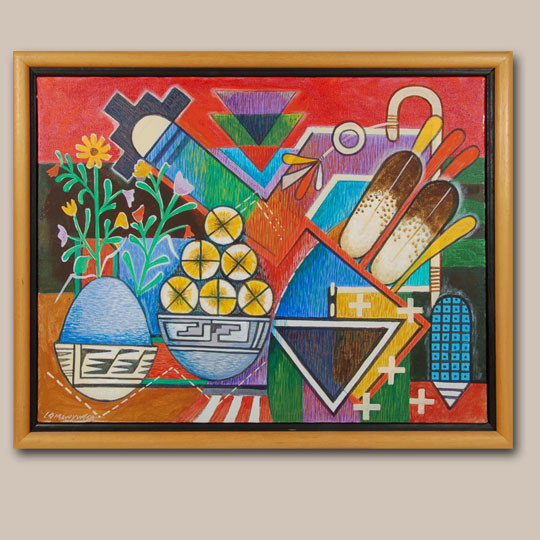 Michael Kabotie was the son of famed Hopi artist, Fred Kabotie. Michael passed away at the early age of 67 years at the height of his fame. He had attended Haskell Indian School in Lawrence, Kansas in 1961. In the 1970s and 1980s, he was the spokesman for the Artist Hopid, a group of Hopi artists who worked together.
Michael Kabotie was the son of famed Hopi artist, Fred Kabotie. Michael passed away at the early age of 67 years at the height of his fame. He had attended Haskell Indian School in Lawrence, Kansas in 1961. In the 1970s and 1980s, he was the spokesman for the Artist Hopid, a group of Hopi artists who worked together.
Navajo Floor Rug with Klagetoh Pattern - C3624D
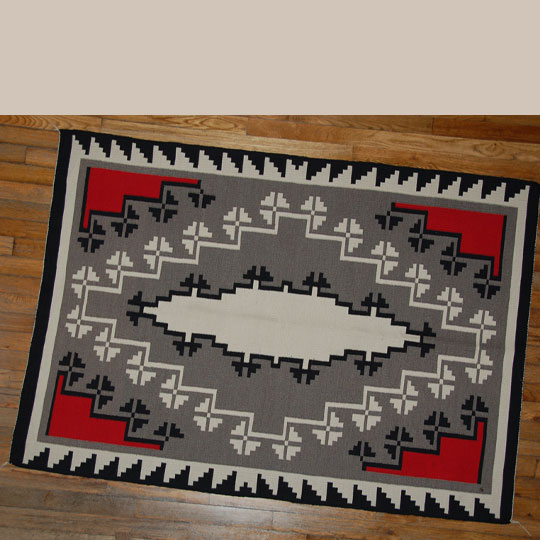 Navajo textiles woven in the Ganado and Klagetoh areas of the reservation are quite similar in style and often it is difficult to determine which region the weaver is from. Generally, weavers from the Ganado region use a large amount of red in their textiles. Patterns associated with weavers from the Klagetoh area consist of a large diamond in the center of the textile surrounded by a border or borders of stepped and hook designs.
Navajo textiles woven in the Ganado and Klagetoh areas of the reservation are quite similar in style and often it is difficult to determine which region the weaver is from. Generally, weavers from the Ganado region use a large amount of red in their textiles. Patterns associated with weavers from the Klagetoh area consist of a large diamond in the center of the textile surrounded by a border or borders of stepped and hook designs.
Historic Zia Pueblo Olla with Avian and Floral Designs - 25715
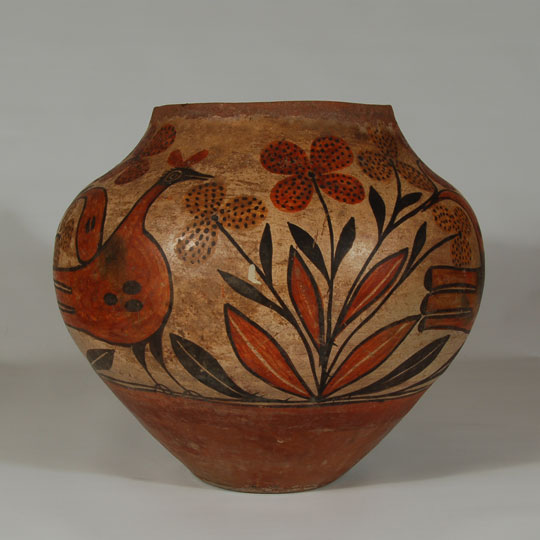 Split leaves, such as the orange and black ones on this jar, have existed on Zia Pueblo pottery since around the mid-1800s. This evolved by the 1880s to more plants, stems, flowers and berries usually associated with birds. The blooming plants on this jar have their roots attached to the pair of lower framing lines and they blossom upward into beautiful dotted flowers. The Zia birds associated with the design have their feet resting on the framing lines and they stand with head upright and wings raised above the body. The birds are outlined in black but the flowers are not outlined.
Split leaves, such as the orange and black ones on this jar, have existed on Zia Pueblo pottery since around the mid-1800s. This evolved by the 1880s to more plants, stems, flowers and berries usually associated with birds. The blooming plants on this jar have their roots attached to the pair of lower framing lines and they blossom upward into beautiful dotted flowers. The Zia birds associated with the design have their feet resting on the framing lines and they stand with head upright and wings raised above the body. The birds are outlined in black but the flowers are not outlined.
Black Carved Tall Neck San Ildefonso Jar by Rose Gonzales - C3623E
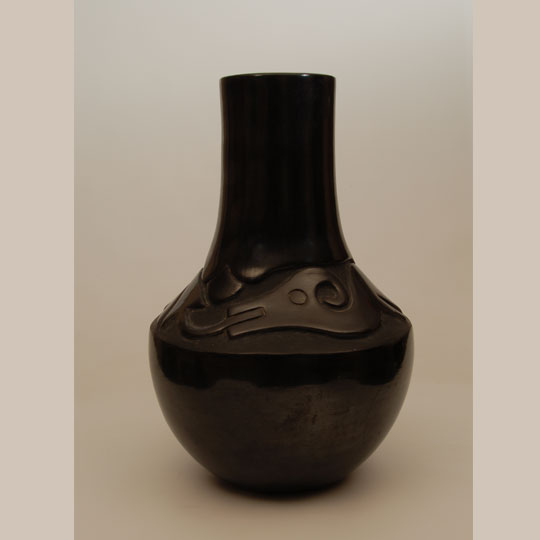 Rose Gonzales was born at San Juan Pueblo (now Ohkay Owingeh) in 1900 and, soon after, became an orphan when her parents died from the flu epidemic. She and her sister survived by attending the Santa Fe Indian School in residence. She married Robert Gonzales of San Ildefonso Pueblo in 1920 and moved to his pueblo at that time. She learned the art of pottery making from Robert's mother, Ramona Sanchez Gonzales.
Rose Gonzales was born at San Juan Pueblo (now Ohkay Owingeh) in 1900 and, soon after, became an orphan when her parents died from the flu epidemic. She and her sister survived by attending the Santa Fe Indian School in residence. She married Robert Gonzales of San Ildefonso Pueblo in 1920 and moved to his pueblo at that time. She learned the art of pottery making from Robert's mother, Ramona Sanchez Gonzales.

